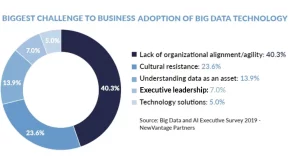Aligning business processes with analytics is vital for creating meaningful analytical insights and developing business strategy. Gartner predicted that in 2022, only “20% of analytics will deliver business insights” due to organizations’ lack of knowledge surrounding the leveraging and implementation of valuable data.
Many companies are not aware of how analytics can impact their data strategy, from eliminating the guesswork in business insights, to providing real value from the time, resources, and energy invested into it. Even though production of valuable insights has accelerated, actually implementing them and not just letting them die on a report or dashboard requires business alignment and adoption in the last mile of analytics.
Getting Started with Analytics
Aligning the “production of insights” with business strategy requires across-the-board understanding of both use-case scope and efforts in delivery. Being able to communicate how data-driven decision making will help achieve business goals is vital to receiving sponsorship as well. For this understanding to occur, both “designers” and “deliverers” need to be brought together in cross-functional collaboration as early on as possible.
Development of a data strategy needs to closely connect and unify—from the CEO creating the vision, to the employees equipped with actionable data to execute. This improves focus to eliminate low-ROI projects while elevating the organization’s data culture.
Understanding the Problem
Defining and scoping the use case properly across all stakeholders will usually include uncomfortable discussions, uncovering organizational, data and technology issues. A third party may be necessary, since experienced partners can help navigate architecture, technology and organizational complexities. Finding the “right partner” can’t be understated; the first of two rare differentiators to look for is flexibility in the delivery model, from an end-to-end solution to advisory or implementation & support. This means that there is no inherent interest to push a specific approach or create dependencies that aren’t beneficial in the long run; rather, it empowers your organization with the tools and processes to up-skill your current workforce. The second differentiator is the experience of working with multiple technologies and deep understanding of digital transformation at an organizational level in order to help ensure adoption.

Applying the Process
With everyone in the room early on, implications of scope, implementation and adoption can be discussed in parallel, which results in processes and platforms that are more clear and adaptable. By empowering your teams with specialized platforms and systems for them to scale across the organization, analytics leaders or solutions center members can embed with cross-function departments seamlessly. Regardless of how great the vision or how ground-breaking the technology, adoption is driven by focus on process over goals. This might explain why only 38% of companies believe they operate as a data-driven organization, even with the billions spent on analytics technologies.
The Importance of Culture
As expected, people and processes are reported as the biggest challenges in the transition to being a data-driven company. For the fourth consecutive year, over 90 percent of executives point to culture as the greatest impediment to achieving this business outcome in 2022, while only 8.1 percent cite technology limitations as the primary impediment. This should speak to the importance of empowering current teams over thinking that hiring is always the answer.
Getting there
Unifying every stakeholder around a use case through the shared ownership of a process can be key in driving adoption. A robust platform, practices and support for both data and business functions can be far more effective than hiring to create a solution that ends in disuse. With a “Solutions Center” approach that fosters ownership across the organization, early wins can accelerate shifting company culture on the journey to a data-driven organization.

